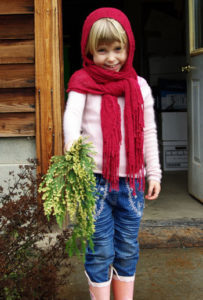
Standard planting technique means fill a deep flat or a pot with soil, or prepare a weed-free seedbed in the garden outside. Work the soil until friable, neither too dry nor too wet, and add some compost to help keep it loose and spongy. Seed packet in hand, kneel before the soil and take a good deep breath. Enjoy the moment. You are about to participate in the life force. Make a shallow furrow with your finger, just barely a mark, really. Take a seed out of the packet and have a chat with it. Get to know it, so that when it comes up later, you will recognize it! Then, plant it in the furrow. After that, sprinkle more seeds in a row in the furrow and cover them all with a little soil. Collective wisdom on this is “Bury the seed as deeply as it is thick,” which means for all practical purposes barely cover the seed with soil.
If planting in pots, do NOT put one seed in each pot and expect that in a little while you’ll have a whole collection of perfectly potted plants. That’s unreasonable expectation, and is certain to breed disappointment. Put at least 3 seeds in each pot. If they all come up, you can thin out the little ones later and keep the best one. This is known as selecting for vigor.
One thing many new grower miss is this next part: pat down the planting with the palm of your hand to give the seed a sense of place, some back-pressure to assure that the seed will stay nicely situated when it is watered and when it extends its root down into the soil. This is known as tamping. Keep track of where you planted your seeds by way of a stake and a tag. You might be tempted to skip all that, but if you do, you’ll regret it! Unless the packet tells you to do differently, keep the seeds warm and evenly moist until they germinate.
When watering, water very carefully so-as not to dislodge the seeds. The soil should swell and embrace them. Most seeds like this treatment. Now you will be happy that you had that little chat, because you will recognize the seed when it comes up. Perhaps it is basil, with little cotyledons like the butt of a baby. This is not the chickweed and the lamb’s quarters that came up first–it is the basil that you planted. After that basil gets a bit bigger, you probably want to pull out the imposters lest they put too much pressure on your little crop. Now you’re rocking—you are already engaging in organic agriculture: preparing the soil, planting the seed, tamping, watering in the seed, pulling out the weeds, cultivating around your little darlings. This is fun, food, joy of life—its what you were after all along!
Here’s an excerpt from my book Growing Plant Medicine:
It is our birthright to garden. Plants need our care, and as breathers of air and consumers of salads, it is hard to deny our interdependency with plants. Nurturing the soil is the same as nurturing our own bodies. When we serve the plants, they return the favor by delighting us with their colors, fragrances, tastes, and energy. Their gentle medicine makes us well. Growing a garden of medicinal herbs is like inviting humming birds, butterflies, and violets over for the tea. Serve the plants and be served by them. It is the work and joy of a lifetime.